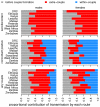Extra-couple HIV transmission in sub-Saharan Africa: a mathematical modelling study of survey data
- PMID: 23391466
- PMCID: PMC3703831
- DOI: 10.1016/S0140-6736(12)61960-6
Extra-couple HIV transmission in sub-Saharan Africa: a mathematical modelling study of survey data
Abstract
Background: The proportion of heterosexual HIV transmission in sub-Saharan Africa that occurs within cohabiting partnerships, compared with that in single people or extra-couple relationships, is widely debated. We estimated the proportional contribution of different routes of transmission to new HIV infections. As plans to use antiretroviral drugs as a strategy for population-level prevention progress, understanding the importance of different transmission routes is crucial to target intervention efforts.
Methods: We built a mechanistic model of HIV transmission with data from Demographic and Health Surveys (DHS) for 2003-2011, of 27,201 cohabiting couples (men aged 15-59 years and women aged 15-49 years) from 18 sub-Saharan African countries with information about relationship duration, age at sexual debut, and HIV serostatus. We combined this model with estimates of HIV survival times and country-specific estimates of HIV prevalence and coverage of antiretroviral therapy (ART). We then estimated the proportion of recorded infections in surveyed cohabiting couples that occurred before couple formation, between couple members, and because of extra-couple intercourse.
Findings: In surveyed couples, we estimated that extra-couple transmission accounted for 27-61% of all HIV infections in men and 21-51% of all those in women, with ranges showing intercountry variation. We estimated that in 2011, extra-couple transmission accounted for 32-65% of new incident HIV infections in men in cohabiting couples, and 10-47% of new infections in women in such couples. Our findings suggest that transmission within couples occurs largely from men to women; however, the latter sex have a very high-risk period before couple formation.
Interpretation: Because of the large contribution of extra-couple transmission to new HIV infections, interventions for HIV prevention should target the general sexually active population and not only serodiscordant couples.
Funding: US National Institutes of Health, US National Science Foundation, and J S McDonnell Foundation.
Copyright © 2013 Elsevier Ltd. All rights reserved.
Figures




Comment in
-
Serodiscordancy and HIV prevention in sub-Saharan Africa.Lancet. 2013 May 4;381(9877):1519-21. doi: 10.1016/S0140-6736(13)60147-6. Epub 2013 Feb 5. Lancet. 2013. PMID: 23391463 No abstract available.
References
-
- Zachariah R, Harries AD, Philips M, Arnould L, Sabapathy K, O,ÄôBrien DP, et al. Antiretroviral therapy for HIV prevention: many concerns and challenges, but are there ways forward in sub-Saharan Africa? Transactions of the Royal Society of Tropical Medicine and Hygiene. 2010;104(6):387–91. - PubMed
Publication types
MeSH terms
Grants and funding
LinkOut - more resources
Full Text Sources
Other Literature Sources
Medical
Research Materials

